这篇文章带大家了解nexus私服的内容,我们在maven编译的时候需要拉取很多依赖,如果是用maven官方的中央仓库拉取的话,有些依赖比较缓慢,影响构建速度。我们通常有两种解决方式,一种是将maven拉取镜像的数据源修改成阿里云这种国内的镜像,还有一种是可以配置一个nexus私服,去保存一些常见的依赖,也可以当yum仓库使用,存放rpm包,这种nexus私服,类似于yum仓库,harbor仓库。
修改Maven数据源
我们先来介绍第一种提升Maven构建速度的方式,修改成国内的数据源。
1、将下面的配置内容复制到我们maven的配置文件里,找mirror字样的。
<mirror>
<id>nexus-aliyun</id>
<mirrorOf>*</mirrorOf>
<name>Nexus aliyun</name>
<url>http://maven.aliyun.com/nexus/content/groups/public</url>
</mirror>

2、测试数据源是否是通过阿里云的源下载。
[root@Jenkins ~]# cd hello-world-war/
[root@Jenkins hello-world-war]# mvn clean
...
Downloaded: http://maven.aliyun.com/nexus/content/groups/public/org/codehaus/plexus/plexus-utils/3.0/plexus-utils-3.0.jar (0 B at 0.0 KB/sec)
...
[root@Jenkins hello-world-war]# mvn package
...
Downloaded: http://maven.aliyun.com/nexus/content/groups/public/org/apache/maven/shared/maven-filtering/1.0-beta-2/maven-filtering-1.0-beta-2.jar (0 B at 0.0 KB/sec)
[INFO] Packaging webapp
[INFO] Assembling webapp [hello-world-war] in [/root/hello-world-war/target/hello-world-war-1.0.0]
[INFO] Processing war project
[INFO] Copying webapp resources [/root/hello-world-war/src/main/webapp]
[INFO] Webapp assembled in [268 msecs]
[INFO] Building war: /root/hello-world-war/target/hello-world-war-1.0.0.war
[INFO] WEB-INF/web.xml already added, skipping
[INFO] ------------------------------------------------------------------------
[INFO] BUILD SUCCESS
[INFO] ------------------------------------------------------------------------
[INFO] Total time: 45.227 s
[INFO] Finished at: 2023-09-05T22:30:52+08:00
[INFO] Final Memory: 11M/77M
[INFO] ------------------------------------------------------------------------
部署Nexus
浏览器访问:https://www.sonatype.com/download-oss-sonatype
进入nexus官网,填写一些信息,点击download就可以下载了,但是需要填公司邮箱,蛮麻烦的,文末有我自己准备的nexus-3.13.0-01-unix.tar下载链接,相对方便些。
[root@Nexus ~]# rpm -ivh jdk-8u181-linux-x64.rpm
[root@Nexus ~]# tar xf nexus-3.13.0-01-unix.tar.gz
[root@Nexus ~]# mv nexus-3.13.0-01 /usr/local/nexus
[root@Nexus ~]# /usr/local/nexus/bin/nexus start
WARNING: ************************************************************
WARNING: Detected execution as "root" user. This is NOT recommended!
WARNING: ************************************************************
Starting nexus
[root@Nexus ~]# /usr/local/nexus/bin/nexus status
WARNING: ************************************************************
WARNING: Detected execution as "root" user. This is NOT recommended!
WARNING: ************************************************************
nexus is running.
需要多等一会,大概几分钟。因为他是把内存变成了仓库,如果担心出问题可以使用/usr/local/nexus/bin/nexus run,在前台运行
端口是8081,有端口后浏览器访问10.0.0.202:8081即可。
[root@Nexus nexus]# ss -ntl|grep 8081
LISTEN 0 50 *:8081 *:*

Nexus基础配置与使用
右上角登陆用户,账号admin,密码admin123

1、配置备用依赖源
点进center仓库
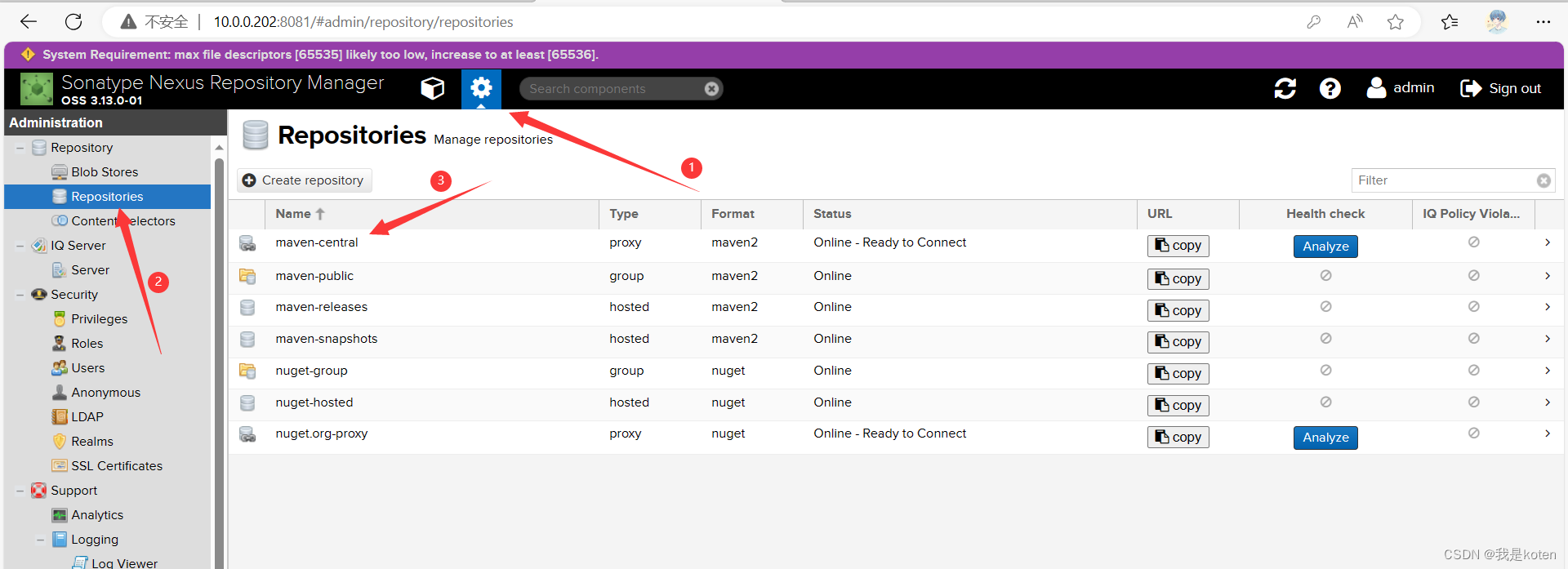
更换备用源为阿里源,如果这个仓库中没有相应的依赖,会从阿里源去拉取。
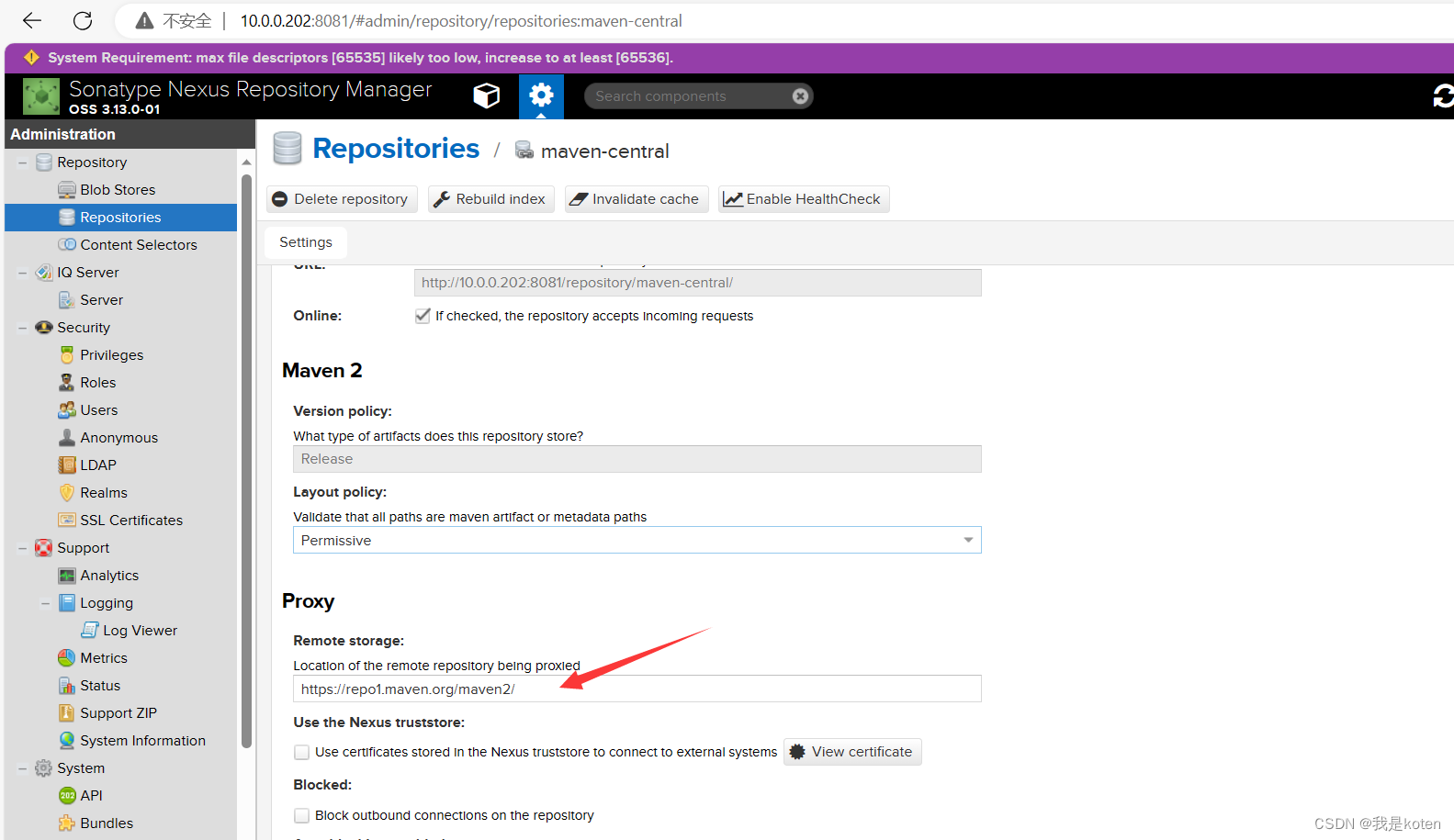
修改后下滑保存
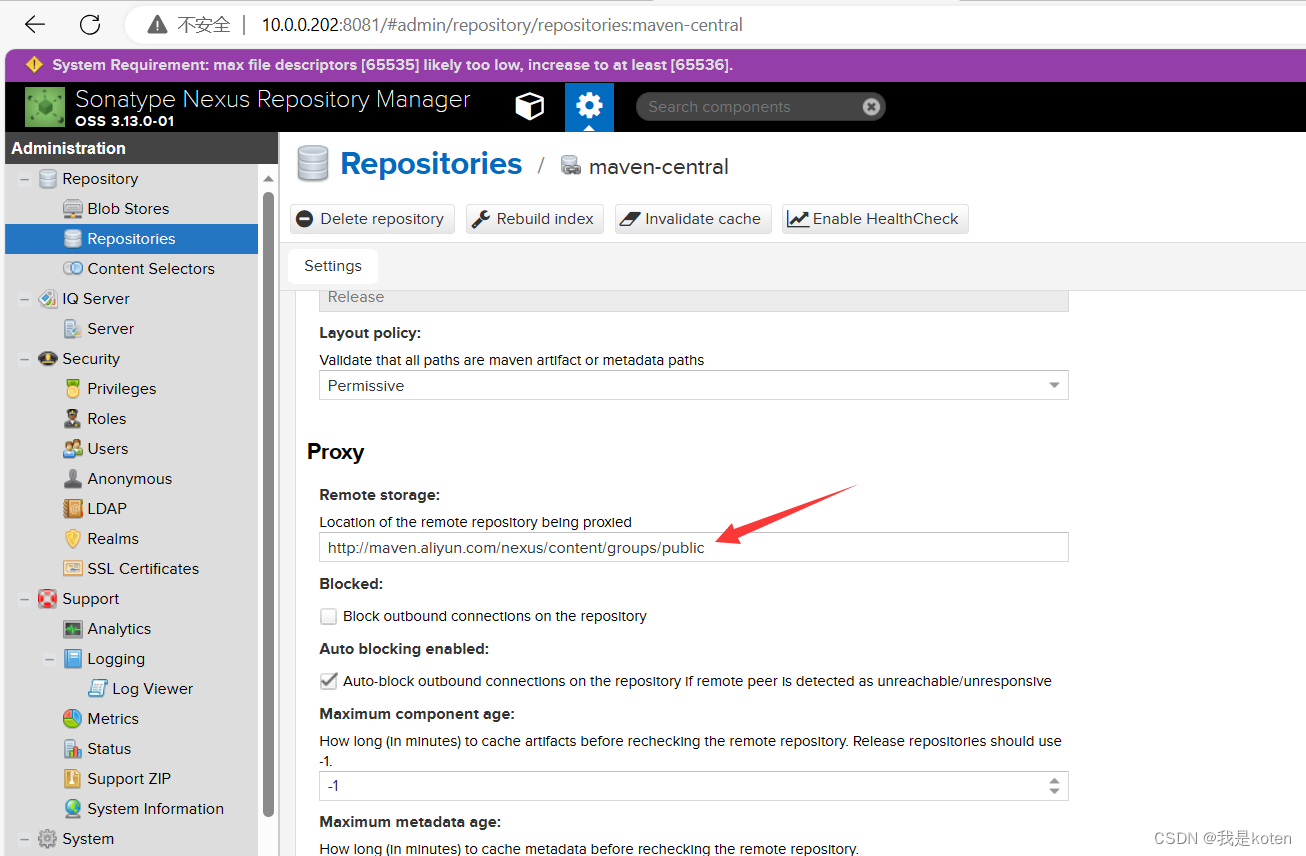
2、复制public源

http://10.0.0.202:8081/repository/maven-public/
复制上面的地址,把它替换到maven配置文件中即可。

下滑可以看到在这个镜像仓库的组里有三个成员,在上面的源搜索其实是在这三个仓库里去寻找依赖,如果这三个库都没有,就会去刚才配置的阿里源里面去寻找。
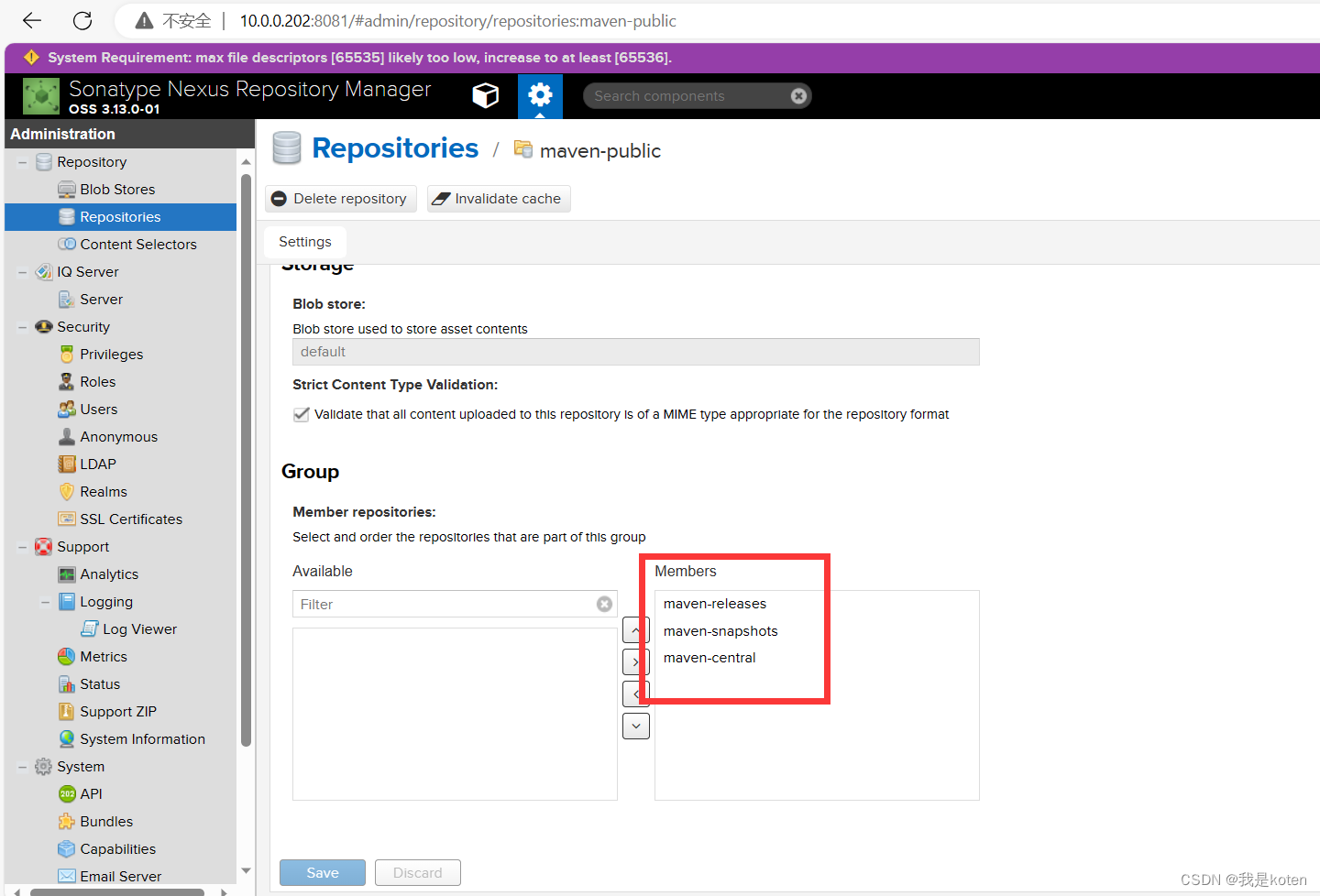
3、改动maven的依赖源
需要改动的地方很多,可以直接复制我改好的作为setting.xml
[root@Jenkins ~]# cd /usr/local/maven/conf/
[root@Jenkins conf]# mv settings.xml settings.xml.bak
[root@Jenkins conf]# cat settings.xml
<?xml version="1.0" encoding="UTF-8"?>
<!--
Licensed to the Apache Software Foundation (ASF) under one
or more contributor license agreements. See the NOTICE file
distributed with this work for additional information
regarding copyright ownership. The ASF licenses this file
to you under the Apache License, Version 2.0 (the
"License"); you may not use this file except in compliance
with the License. You may obtain a copy of the License at
http://www.apache.org/licenses/LICENSE-2.0
Unless required by applicable law or agreed to in writing,
software distributed under the License is distributed on an
"AS IS" BASIS, WITHOUT WARRANTIES OR CONDITIONS OF ANY
KIND, either express or implied. See the License for the
specific language governing permissions and limitations
under the License.
-->
<!--
| This is the configuration file for Maven. It can be specified at two levels:
|
| 1. User Level. This settings.xml file provides configuration for a single user,
| and is normally provided in ${user.home}/.m2/settings.xml.
|
| NOTE: This location can be overridden with the CLI option:
|
| -s /path/to/user/settings.xml
|
| 2. Global Level. This settings.xml file provides configuration for all Maven
| users on a machine (assuming they're all using the same Maven
| installation). It's normally provided in
| ${maven.home}/conf/settings.xml.
|
| NOTE: This location can be overridden with the CLI option:
|
| -gs /path/to/global/settings.xml
|
| The sections in this sample file are intended to give you a running start at
| getting the most out of your Maven installation. Where appropriate, the default
| values (values used when the setting is not specified) are provided.
|
|-->
<settings xmlns="http://maven.apache.org/SETTINGS/1.0.0"
xmlns:xsi="http://www.w3.org/2001/XMLSchema-instance"
xsi:schemaLocation="http://maven.apache.org/SETTINGS/1.0.0 http://maven.apache.org/xsd/settings-1.0.0.xsd">
<!-- localRepository
| The path to the local repository maven will use to store artifacts.
|
| Default: ${user.home}/.m2/repository
<localRepository>/path/to/local/repo</localRepository>
-->
<!-- interactiveMode
| This will determine whether maven prompts you when it needs input. If set to false,
| maven will use a sensible default value, perhaps based on some other setting, for
| the parameter in question.
|
| Default: true
<interactiveMode>true</interactiveMode>
-->
<!-- offline
| Determines whether maven should attempt to connect to the network when executing a build.
| This will have an effect on artifact downloads, artifact deployment, and others.
|
| Default: false
<offline>false</offline>
-->
<!-- pluginGroups
| This is a list of additional group identifiers that will be searched when resolving plugins by their prefix, i.e.
| when invoking a command line like "mvn prefix:goal". Maven will automatically add the group identifiers
| "org.apache.maven.plugins" and "org.codehaus.mojo" if these are not already contained in the list.
|-->
<pluginGroups>
<!-- pluginGroup
| Specifies a further group identifier to use for plugin lookup.
<pluginGroup>com.your.plugins</pluginGroup>
-->
</pluginGroups>
<!-- proxies
| This is a list of proxies which can be used on this machine to connect to the network.
| Unless otherwise specified (by system property or command-line switch), the first proxy
| specification in this list marked as active will be used.
|-->
<proxies>
<!-- proxy
| Specification for one proxy, to be used in connecting to the network.
|
<proxy>
<id>optional</id>
<active>true</active>
<protocol>http</protocol>
<username>proxyuser</username>
<password>proxypass</password>
<host>proxy.host.net</host>
<port>80</port>
<nonProxyHosts>local.net|some.host.com</nonProxyHosts>
</proxy>
-->
</proxies>
<!-- servers
| This is a list of authentication profiles, keyed by the server-id used within the system.
| Authentication profiles can be used whenever maven must make a connection to a remote server.
|-->
<servers>
<!-- server
| Specifies the authentication information to use when connecting to a particular server, identified by
| a unique name within the system (referred to by the 'id' attribute below).
|
| NOTE: You should either specify username/password OR privateKey/passphrase, since these pairings are
| used together.
|
<server>
<id>deploymentRepo</id>
<username>repouser</username>
<password>repopwd</password>
</server>
-->
<!-- Another sample, using keys to authenticate.
<server>
<id>siteServer</id>
<privateKey>/path/to/private/key</privateKey>
<passphrase>optional; leave empty if not used.</passphrase>
</server>
-->
<server>
<id>my-nexus-releases</id>
<username>admin</username>
<password>admin123</password>
</server>
<server>
<id>my-nexus-snapshot</id>
<username>admin</username>
<password>admin123</password>
</server>
</servers>
<!-- mirrors
| This is a list of mirrors to be used in downloading artifacts from remote repositories.
|
| It works like this: a POM may declare a repository to use in resolving certain artifacts.
| However, this repository may have problems with heavy traffic at times, so people have mirrored
| it to several places.
|
| That repository definition will have a unique id, so we can create a mirror reference for that
| repository, to be used as an alternate download site. The mirror site will be the preferred
| server for that repository.
|-->
<mirrors>
<mirror>
<id>nexus</id>
<mirrorOf>*</mirrorOf>
<url>http://10.0.0.202:8081/repository/maven-public/</url>
</mirror>
<!-- mirror
| Specifies a repository mirror site to use instead of a given repository. The repository that
| this mirror serves has an ID that matches the mirrorOf element of this mirror. IDs are used
| for inheritance and direct lookup purposes, and must be unique across the set of mirrors.
|
<mirror>
<id>mirrorId</id>
<mirrorOf>repositoryId</mirrorOf>
<name>Human Readable Name for this Mirror.</name>
<url>http://my.repository.com/repo/path</url>
</mirror>
-->
</mirrors>
<!-- profiles
| This is a list of profiles which can be activated in a variety of ways, and which can modify
| the build process. Profiles provided in the settings.xml are intended to provide local machine-
| specific paths and repository locations which allow the build to work in the local environment.
|
| For example, if you have an integration testing plugin - like cactus - that needs to know where
| your Tomcat instance is installed, you can provide a variable here such that the variable is
| dereferenced during the build process to configure the cactus plugin.
|
| As noted above, profiles can be activated in a variety of ways. One way - the activeProfiles
| section of this document (settings.xml) - will be discussed later. Another way essentially
| relies on the detection of a system property, either matching a particular value for the property,
| or merely testing its existence. Profiles can also be activated by JDK version prefix, where a
| value of '1.4' might activate a profile when the build is executed on a JDK version of '1.4.2_07'.
| Finally, the list of active profiles can be specified directly from the command line.
|
| NOTE: For profiles defined in the settings.xml, you are restricted to specifying only artifact
| repositories, plugin repositories, and free-form properties to be used as configuration
| variables for plugins in the POM.
|
|-->
<profiles>
<!-- profile
| Specifies a set of introductions to the build process, to be activated using one or more of the
| mechanisms described above. For inheritance purposes, and to activate profiles via <activatedProfiles/>
| or the command line, profiles have to have an ID that is unique.
|
| An encouraged best practice for profile identification is to use a consistent naming convention
| for profiles, such as 'env-dev', 'env-test', 'env-production', 'user-jdcasey', 'user-brett', etc.
| This will make it more intuitive to understand what the set of introduced profiles is attempting
| to accomplish, particularly when you only have a list of profile id's for debug.
|
| This profile example uses the JDK version to trigger activation, and provides a JDK-specific repo.
<profile>
<id>jdk-1.4</id>
<activation>
<jdk>1.4</jdk>
</activation>
<repositories>
<repository>
<id>jdk14</id>
<name>Repository for JDK 1.4 builds</name>
<url>http://www.myhost.com/maven/jdk14</url>
<layout>default</layout>
<snapshotPolicy>always</snapshotPolicy>
</repository>
</repositories>
</profile>
-->
<!--
| Here is another profile, activated by the system property 'target-env' with a value of 'dev',
| which provides a specific path to the Tomcat instance. To use this, your plugin configuration
| might hypothetically look like:
|
| ...
| <plugin>
| <groupId>org.myco.myplugins</groupId>
| <artifactId>myplugin</artifactId>
|
| <configuration>
| <tomcatLocation>${tomcatPath}</tomcatLocation>
| </configuration>
| </plugin>
| ...
|
| NOTE: If you just wanted to inject this configuration whenever someone set 'target-env' to
| anything, you could just leave off the <value/> inside the activation-property.
|
<profile>
<id>env-dev</id>
<activation>
<property>
<name>target-env</name>
<value>dev</value>
</property>
</activation>
<properties>
<tomcatPath>/path/to/tomcat/instance</tomcatPath>
</properties>
</profile>
-->
<profile>
<id>nexus</id>
<repositories>
<repository>
<id>central</id>
<url>http://10.0.0.202:8081/repository/maven-public/</url>
<releases><enabled>true</enabled></releases>
<snapshots><enabled>true</enabled></snapshots>
</repository>
</repositories>
<pluginRepositories>
<pluginRepository>
<id>central</id>
<url>http://10.0.0.202:8081/repository/maven-public/</url>
<releases><enabled>true</enabled></releases>
<snapshots><enabled>true</enabled></snapshots>
</pluginRepository>
</pluginRepositories>
</profile>
</profiles>
<!-- activeProfiles
| List of profiles that are active for all builds.
|
<activeProfiles>
<activeProfile>alwaysActiveProfile</activeProfile>
<activeProfile>anotherAlwaysActiveProfile</activeProfile>
</activeProfiles>
-->
<activeProfiles>
<activeProfile>nexus</activeProfile>
</activeProfiles>
</settings>
4、试用nexus仓库
[root@Jenkins conf]# cd ~/hello-world-war/
[root@Jenkins hello-world-war]# mvn clean
...
[INFO] Building Hello World Web Application Repository 1.0.0
[INFO] ------------------------------------------------------------------------
Downloading: http://10.0.0.202:8081/repository/maven-public/org/apache/maven/plugins/maven-clean-plugin/2.5/maven-clean-plugin-2.5.pom
...
[root@Jenkins hello-world-war]# mvn package
Downloaded: http://10.0.0.202:8081/repository/maven-public/com/thoughtworks/xstream/xstream/1.3.1/xstream-1.3.1.jar (0 B at 0.0 KB/sec)
[INFO] Packaging webapp
[INFO] Assembling webapp [hello-world-war] in [/root/hello-world-war/target/hello-world-war-1.0.0]
[INFO] Processing war project
[INFO] Copying webapp resources [/root/hello-world-war/src/main/webapp]
[INFO] Webapp assembled in [172 msecs]
[INFO] Building war: /root/hello-world-war/target/hello-world-war-1.0.0.war
[INFO] WEB-INF/web.xml already added, skipping
[INFO] ------------------------------------------------------------------------
[INFO] BUILD SUCCESS
[INFO] ------------------------------------------------------------------------
[INFO] Total time: 01:33 min
[INFO] Finished at: 2023-09-10T20:46:24+08:00
[INFO] Final Memory: 11M/46M
[INFO] ------------------------------------------------------------------------
试用首次package的时候还是需要很久,因为202仓库里面没有这些依赖,需要从阿里源去拉取。
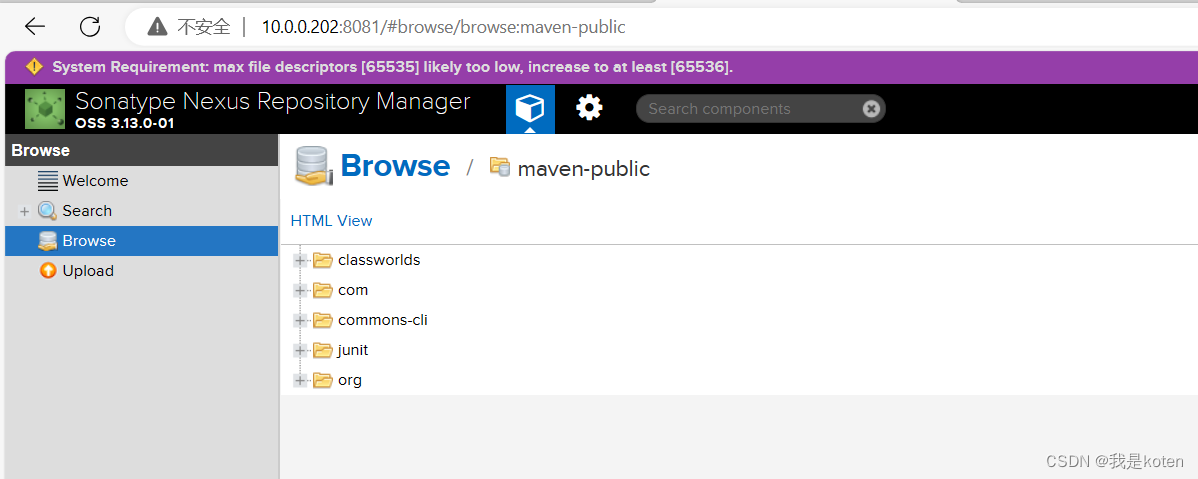
我们再次进行清理和打包,发现打包时间又一分半变成了6秒。
[root@Jenkins hello-world-war]# mvn clean
[root@Jenkins hello-world-war]# mvn package
[INFO] WEB-INF/web.xml already added, skipping
[INFO] ------------------------------------------------------------------------
[INFO] BUILD SUCCESS
[INFO] ------------------------------------------------------------------------
[INFO] Total time: 6.674 s
[INFO] Finished at: 2023-09-10T20:47:31+08:00
[INFO] Final Memory: 10M/97M
[INFO] ------------------------------------------------------------------------
Nexus私服下载链接:https://pan.baidu.com/s/1i0uf1Qy5UuYRJcm_3mLCpw?pwd=7fxh
JDK下载链接:https://pan.baidu.com/s/1sGftvjyOtGI4ji4zRMFi1Q?pwd=nlyo